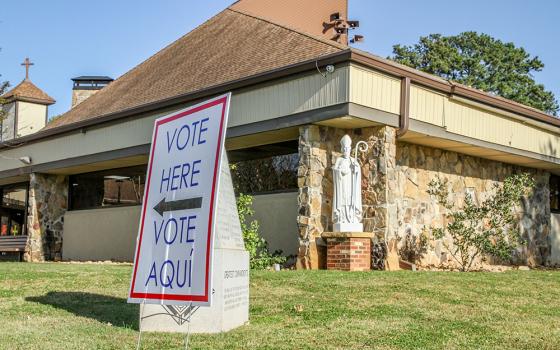![A mosaic depicts St. Clare of Assisi holding a palm frond, a symbol for her entering religious life. (CNS/Octavio Duran) [inset]](/sites/default/files/stories/images/oldimgs/03162012p17pham.jpg)
Essay
Sunday marked the 800th anniversary of the founding of the Poor Clares, the second of the Franciscan orders. Eight hundred years ago on that day, the 18-year-old Chiara Favorone, whom we now know as Clare of Assisi, went to church with her family. It was a Sunday, but not just any Sunday.
This was Palm Sunday, and the day’s events involved every Assisi citizen. In the early morning, people gathered outside the city walls with branches and flowers in hand, waiting for the procession to begin. There was a heightened drama given to the reading of the Passion. A melodious baritone would recite the words of Christ, while a deliberately harsh male voice would call out the chants from the crowd, as well as the words of Judas. It was this sort of dramatic rendering that allowed all to understand what was happening, despite the use of a Latin text.
At the conclusion of Mass, it was then customary for each girl of marriageable age to personally greet the bishop, presenting herself to him in a manner befitting a lady. For most of the girls in town, this represented a high point in the year and was worried over and prepared for for weeks. It was a prelude to their marriage ceremonies, when all eyes were on the bride processing glamorously and joyfully down the aisle, just as now.
But Clare would be different. She refused to show herself as an eligible woman that day. As all of refined Assisi watched, Clare didn’t stand to greet the bishop when her turn came. Her earliest biographer tells us that Francis had instructed Clare how to play along with the drama of the Palm Sunday routine. He told her to dress in fine clothes and go forward with the other girls to receive her palm from the bishop. But Clare decided not to.
 Her conversion to religious life culminated that evening, as she sneaked away from her parents’ home on the eastern edge of town and joined Francis and the friars at Portiuncula, a tiny chapel in the valley below. Imagine a young woman running off in the middle of the night to join a ragtag group of hippie, poverty-loving Francis-followers outside of town. It was scandalous! Her male family members followed and attempted to physically drag her away, but she resisted.
Her conversion to religious life culminated that evening, as she sneaked away from her parents’ home on the eastern edge of town and joined Francis and the friars at Portiuncula, a tiny chapel in the valley below. Imagine a young woman running off in the middle of the night to join a ragtag group of hippie, poverty-loving Francis-followers outside of town. It was scandalous! Her male family members followed and attempted to physically drag her away, but she resisted.
For 800 years now, people have been drawn with curiosity to the lives of Francis and Clare. We look on the personalities and intentions of the first Franciscans as one of those moments in the history of the church when religion was fresh and vibrant. However, a rejection of their families made their religious lives possible. Is that something to emulate?
You have to consider the monastic understanding of conversion. In the sixth century, St. Benedict wrote in his Rule of the importance of undergoing what is called a conversion of life, a renunciation of the past in order to focus solely on what is godly. This includes turning away from everyone who had previously comforted or hindered the candidate. Her old self is now dead and her converted self has begun. By converting, Clare was turning away from the bondage of the world, which she believed to include her family. Her mother, her uncles, her old way of life all stood in the way of her conversion.
Sometimes, the language of monastic conversions can be overblown. Thomas of Celano describes the world that Clare left behind as “the filth of Babylon,” a description that would be absurd if applied to her comfortable home and seemingly loving family. But Thomas uses another phrase to describe Clare fleeing in the middle of the night, from Hebrews 13: She moved “outside the camp,” he wrote, describing Clare’s leaving the safe and familiar for the unknown. Throughout the conversion narratives of both Francis and Clare, when the saints left their families behind, it was as soldiers going to fight the unknown.
Imagine, brothers, if your sister, or, mothers, if your daughter ran away from home and went to live with a group of men considered by most people to be lunatics. What would you do? Would you look upon your runaway sister or daughter as being well on her way to sainthood? Of course not! When the men of Clare’s family came for her, she refused to listen and wouldn’t allow them to remove her. Turning her back on her earthly parents was seen as necessary if it meant that her identity could be fully realized in God. When Clare arrived at Portiuncula on that first night, in the words of one biographer, she “gave to the world her letter of divorce” as she adopted the hair, clothes and vows of a woman married to Christ.
We most often imagine Clare and Francis with birds, flowers and rabbits by their sides, but we might just as well listen to them as prophets who sought an entirely different way of living. They believed that the true freedom that comes from a lack of attachments easily surpasses any negative effects of conversion, such as leaving behind family. Clare and Francis wanted to live as they believed Jesus intended people to live, with lives transformed by a reordering of what it means to be family. Imagine a group of people who truly follow these teachings of Jesus and you will see how the first Franciscans lived with each other. The claims of biological families -- for marriages, children, property, inheritances -- no longer apply. One’s father and mother may be not biologically, but spiritually chosen.
Our oversentimentalizing of children and childhood today probably blurs our ability to see the scene clearly, but back in March 1212, those who observed Clare knew that she was taking a radical but necessary step, choosing who her family would be. Would we be able to see it that way today?
[Jon M. Sweeney is the author of The St. Clare Prayer Book: Listening for God’s Leading and The Pope Who Quit: A True Medieval Tale of Mystery, Death, and Salvation, about Celestine V, just published by Image Books.]


